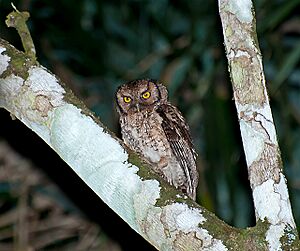Black-capped screech owl facts for kids
Quick facts for kids Black-capped screech owl |
|
|---|---|
 |
|
| In São Paulo, Brazil | |
| Conservation status | |
| Scientific classification | |
| Genus: |
Megascops
|
| Species: |
atricapilla
|
 |
|
| Synonyms | |
|
Otus atricapilla (Temminck, 1822) |
|
The black-capped screech owl is a cool type of owl that lives in parts of South America. You can find it in countries like Argentina, Brazil, and Paraguay. It's also sometimes called the variable screech owl. This owl belongs to the Strigidae family, which includes most of the owls we know.
Contents
About This Owl
The black-capped screech owl is a unique bird. It is the only species in its group, meaning it doesn't have different subspecies. However, scientists think it's related to other screech owls. These include the Santa Marta screech owl and the tawny-bellied screech owl. There might even be other types of screech owls that haven't been discovered yet!
What It Looks Like
The black-capped screech owl is about 22 to 23 cm (8.7 to 9.1 in) long. That's about the size of a small ruler. Males usually weigh between 115 to 140 g (4.1 to 4.9 oz). Females can be a bit heavier, weighing up to 160 g (5.6 oz).
These owls can look different from each other. Some are brown, some are reddish, and some are gray. This is called having different "morphs." All of them have a light face with a dark border. They also have a blackish cap on their head and noticeable "ear" tufts. Their eyes can be dark brown or even amber.
If an owl is a brown morph, its top feathers are dark brown. They have lighter spots and wavy lines. When its wings are folded, you can see a line of pale spots. Their belly and chest are lighter with irregular markings. The other morphs are similar but with more red or gray colors.
Where It Lives
You can find the black-capped screech owl in southeastern Brazil. It also lives in southeastern Paraguay and the very northeastern part of Argentina.
This owl likes many different places to live. It especially enjoys lowland rainforests. You can also find it in forests with thick plants on the ground. It lives along forest edges, in open woodlands, and in forests that have grown back. In the northern areas, it lives from sea level up to about 600 m (2,000 ft) high. In the southern areas, it lives up to about 300 m (980 ft) high.
How It Behaves
Hunting for Food
The black-capped screech owl usually hunts high up in the trees. It sits on a branch and looks for food. But it also often hunts closer to the ground in thick plants. Its main food is insects. It probably eats small animals too, like tiny mammals or birds.
Raising a Family
The breeding season for these owls seems to be in October and November. However, scientists are still learning more about it. They build their nests in holes in trees. These can be natural holes or ones made by woodpeckers. Sometimes, these owls nest close to each other. This might mean they live in small groups.
Owl Sounds
The main song of the black-capped screech owl is a long, fast trill. It starts very quietly and then gets louder. It ends suddenly. Their second song is short and sounds like a bouncing ball. Both male and female owls sing together. The female's voice is higher pitched.
Its Conservation Status
The IUCN (International Union for Conservation of Nature) says the black-capped screech owl is a species of "Least Concern." This means it is not currently in danger of disappearing. We don't know exactly how many of these owls there are. We also don't know if their numbers are growing or shrinking.
These owls seem to need large areas of forest to survive. It might be hard for them to live in small forest areas. Protecting their forest homes is important for their future.


